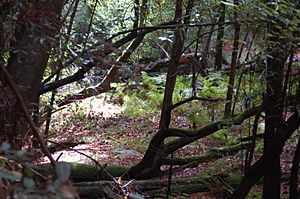California mixed evergreen forest facts for kids

Imagine a forest where some trees have needles and cones, and others have wide, flat leaves that stay green all year! That's a California mixed evergreen forest. These special forests are found in the mountains of California and southwestern Oregon. They are called "mixed evergreen" because they have a mix of both conifer trees (like pines and firs) and broadleaf evergreen trees (like oaks and madrones). All these trees keep their leaves or needles throughout the year.
These forests grow in many parts of California, including the California Coast Ranges, the Sierra Nevada mountains, and the Transverse Ranges and Peninsular Ranges in southern California. They are also found in the southwestern Oregon Coast Ranges. Depending on where they are, the exact types of trees in these forests can be a little different.
Contents
Forests of the Klamath-Siskiyou Mountains
The mixed evergreen forests in the Klamath Mountains and Siskiyou Mountains are usually found above 300 meters (about 1,000 feet) high. There are a few main types of these forests.
Douglas-fir Forests
In some areas, especially on gentle slopes or where the soil is deep, you'll find lots of Coast Douglas-fir trees. They can make up most of the forest! Other important trees here include:
Forests on Different Soils
The type of soil can change which trees grow best.
- On granite soils, you'll still see Douglas-firs, but also more broadleaf evergreen trees like Tanoak and Canyon live oak. You might also spot Giant chinquapin.
- On steep, well-drained slopes, Canyon live oak is often the main tree.
- On special soils called serpentine soils, the forests have unique trees. In wetter spots, you might find Lawson's cypress (also called Port Orford cedar) and Western white pine. In drier areas, look for Incense cedar, Jeffrey pine, and Knobcone pine.
California Coast Ranges Mixed Evergreen Forests
The mixed evergreen forests in the California Coast Ranges are found from sea level up to about 500 meters high. The types of trees here depend on how close they are to the coast and how much fog and rain they get.
Coastal Forests
Forests closer to the coast get plenty of fog and rain. They often have a mix of tall conifers and broadleaf evergreen trees. The tall conifers form the top layer of the forest, and the broadleaf trees grow just below them. Common trees here include:
- Coast Douglas-fir
- Coast redwood
- Tanoak
- Pacific madrone
- California bay laurel
- Canyon live oak
- Interior live oak
- Coast live oak
- Black oak
- Oregon oak
- Big leaf maple
Inland Forests
Further inland, these forests are drier. They usually don't have tanoak, Douglas fir, or coast redwood. Instead, you might see trees that are common in drier oak woodlands, such as:
Animals in the Forest
These mixed evergreen forests are home to many different animals! You might see birds like the Steller's jay and chestnut-backed chickadee. Mammals like western gray squirrels and raccoons also live here. Because there are so many different kinds of trees, these forests offer more food sources for animals than forests with only one type of tree.
Southern California Mixed Evergreen Forests
In southern California, you'll find these forests in the southern California Coast Ranges, the Transverse Ranges, and the northern Peninsular Ranges. They usually grow on cooler, north-facing slopes at higher elevations.
Common Trees in Southern Forests
The main trees you'll find in these southern mixed evergreen forests include:
- Tanoak
- Madrone
- Canyon live oak
- Coast live oak
- California bay laurel
- Jeffrey pine
- Coulter pine
- Bigcone Douglas-fir

